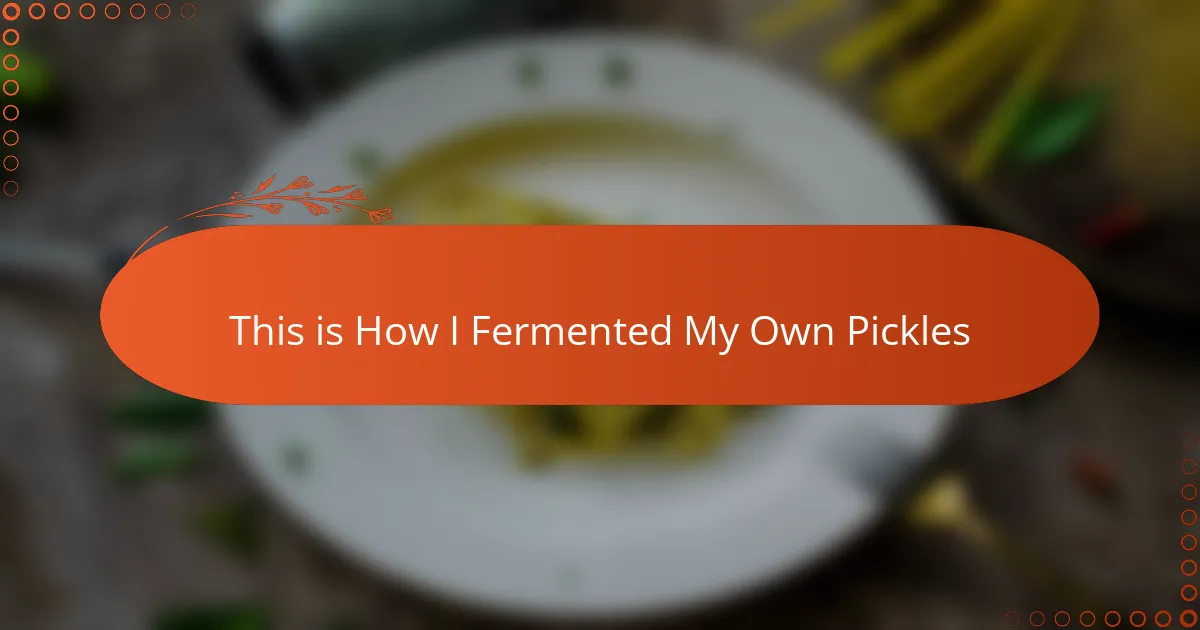Key takeaways
- Fermentation relies on lactobacillus bacteria, turning sugars in cucumbers into lactic acid for preservation and flavor enhancement.
- Essential factors for successful pickling include the right salt concentration, quality water, and fresh cucumbers to ensure optimal crunch and taste.
- Maintaining full submersion of cucumbers in the brine and controlling fermentation temperature are crucial to prevent spoilage and achieve desired flavors.
- Proper storage in a cool, dark place slows down fermentation, keeping pickles fresh and flavorful for longer periods.
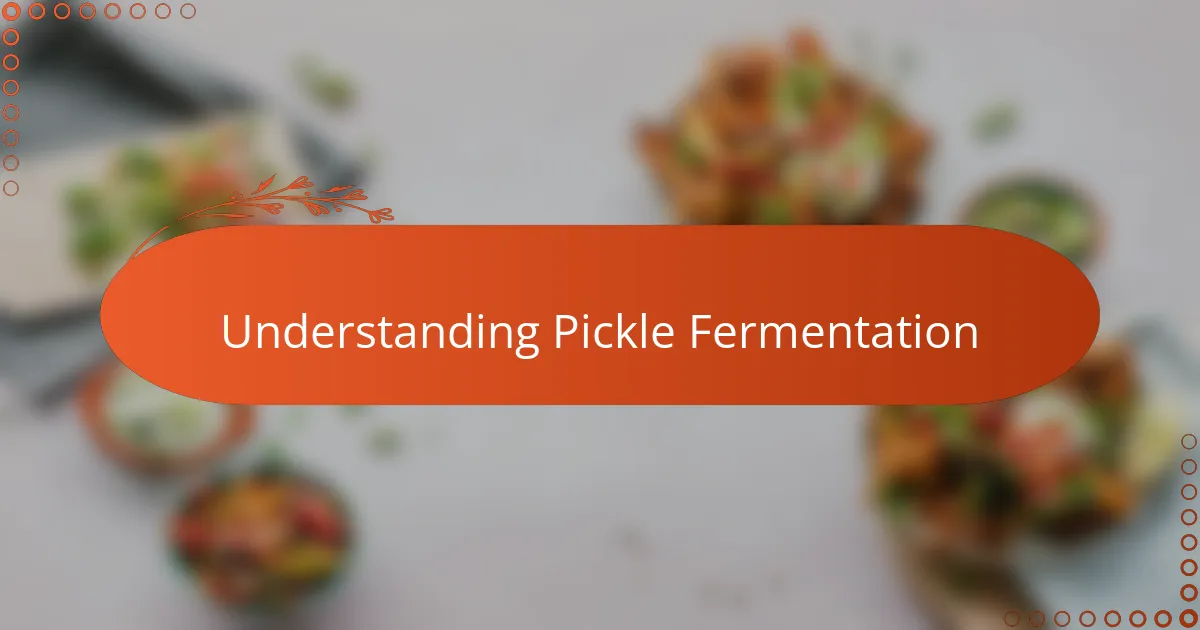
Understanding Pickle Fermentation
Fermentation is essentially a natural preservation process where friendly bacteria, mainly lactobacillus, transform sugars in cucumbers into lactic acid. This acid creates a tangy flavor and acts as a shield against harmful microbes, making your pickles safe to eat and delicious. When I first tried fermenting pickles, I was amazed at how something so simple could lead to such complex flavors.
Have you ever wondered why homemade pickles have that unique crunch and depth of taste that store-bought versions lack? In my experience, it’s all about the slow, hands-off transformation happening in the jar, where saltwater encourages beneficial bacteria to work their magic. It’s almost like watching a living process unfold right in your kitchen, which makes the reward of tasting your own fermented pickles even sweeter.
What I found truly fascinating is how controlling factors like salt concentration, temperature, and time allow you to guide fermentation to your flavor preference. It’s an interactive experience with nature, and every batch tells a new story. Understanding this delicate balance was key for me to move from a nervous beginner to confident pickle-maker.
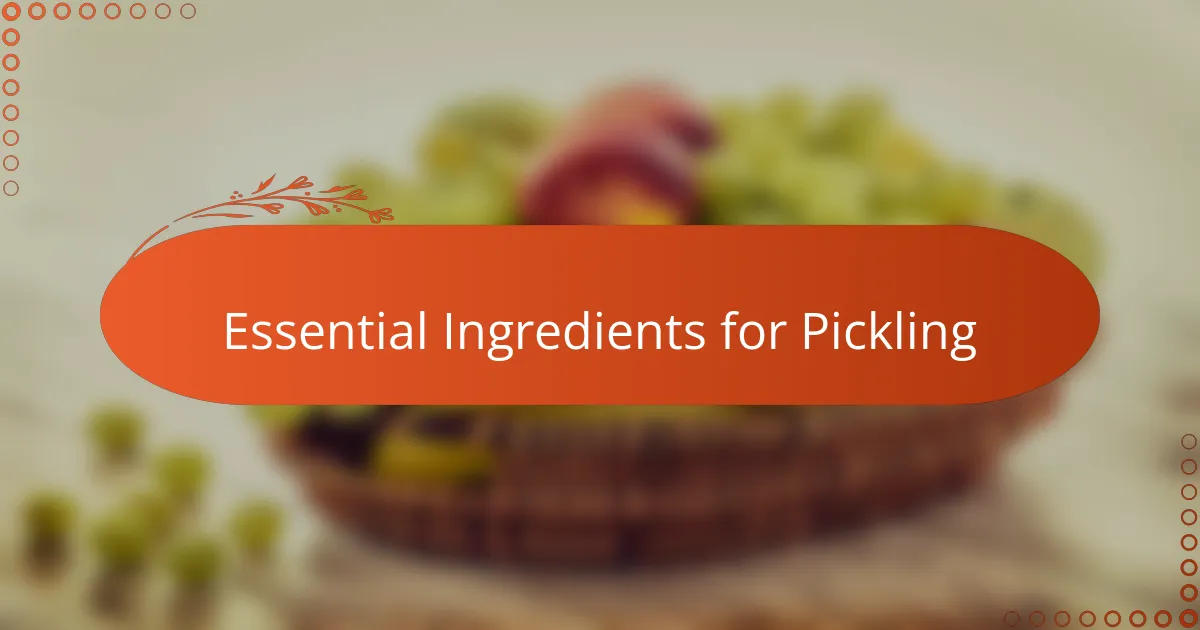
Essential Ingredients for Pickling
Salt is undoubtedly the cornerstone of any pickle fermentation. From my early experiments, I learned that the right amount of salt not only flavors the cucumbers but also creates the perfect environment for those beneficial lactobacillus bacteria to thrive. Have you ever tasted a batch that’s too salty or too bland? That’s the fine line you need to find.
Water seems simple enough, but I quickly realized its quality makes a huge difference. Using filtered or spring water free from chlorine helped me avoid any unwanted flavors or fermentation hiccups. It’s fascinating how even something as basic as water can influence the entire process.
Then there are the cucumbers themselves, which give pickles their crunch and fresh flavor. I always choose firm, fresh cucumbers because mushy ones just won’t hold up during fermentation. Adding herbs and spices like dill or garlic made each batch feel uniquely mine—like weaving little personal touches into a timeless tradition.
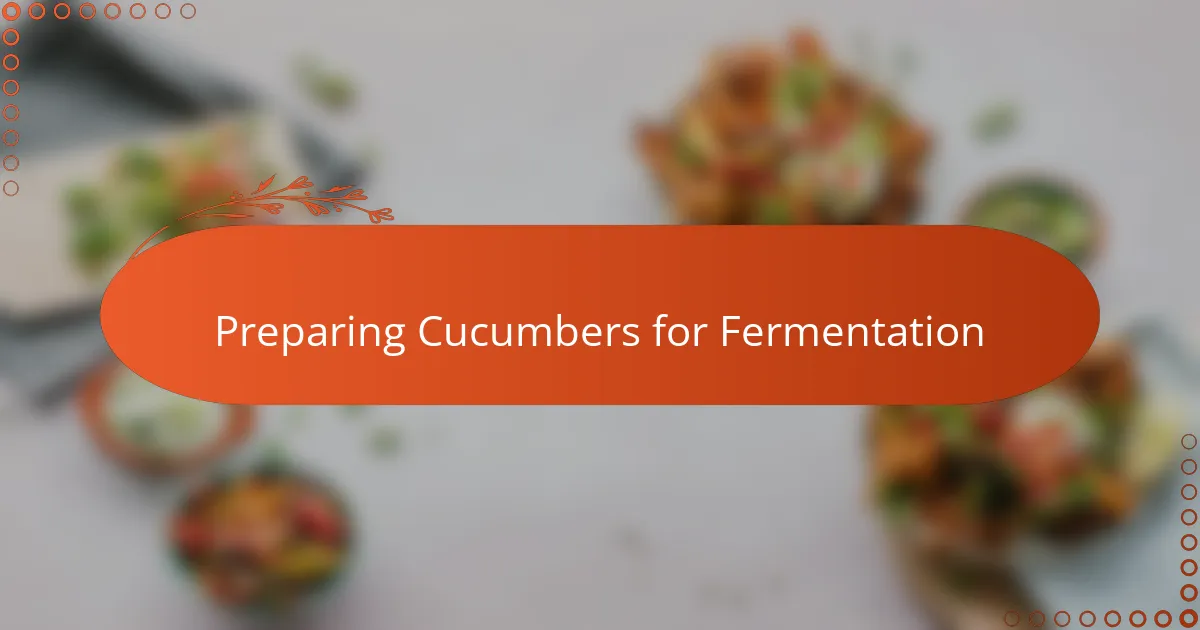
Preparing Cucumbers for Fermentation
Preparing cucumbers for fermentation starts with choosing the right ones—not every cucumber is an equal candidate for pickling. From my experience, the freshest, firmest cucumbers produce the best crunch and texture, while older or soft ones tend to turn mushy during fermentation. Have you ever bitten into a soggy pickle and wondered why it lacked that satisfying snap? That’s usually because the cucumbers weren’t prepared properly or weren’t fresh enough.
Once I selected my cucumbers, I gave them a thorough rinse to remove any dirt or residues. I found that trimming off the blossom ends is a small but crucial step since those ends harbor enzymes that can cause softening. This little detail made a noticeable difference in the firmness of my pickles, and I think it’s often overlooked.
Then came the fun part: cutting and packing. I like to keep some cucumbers whole for classic spears and slice others for quicker fermentation and varied textures. Packing them tightly into the jar while leaving enough room for the brine felt like arranging a tiny, flavorful puzzle—one that promised that satisfying crunch I was craving.
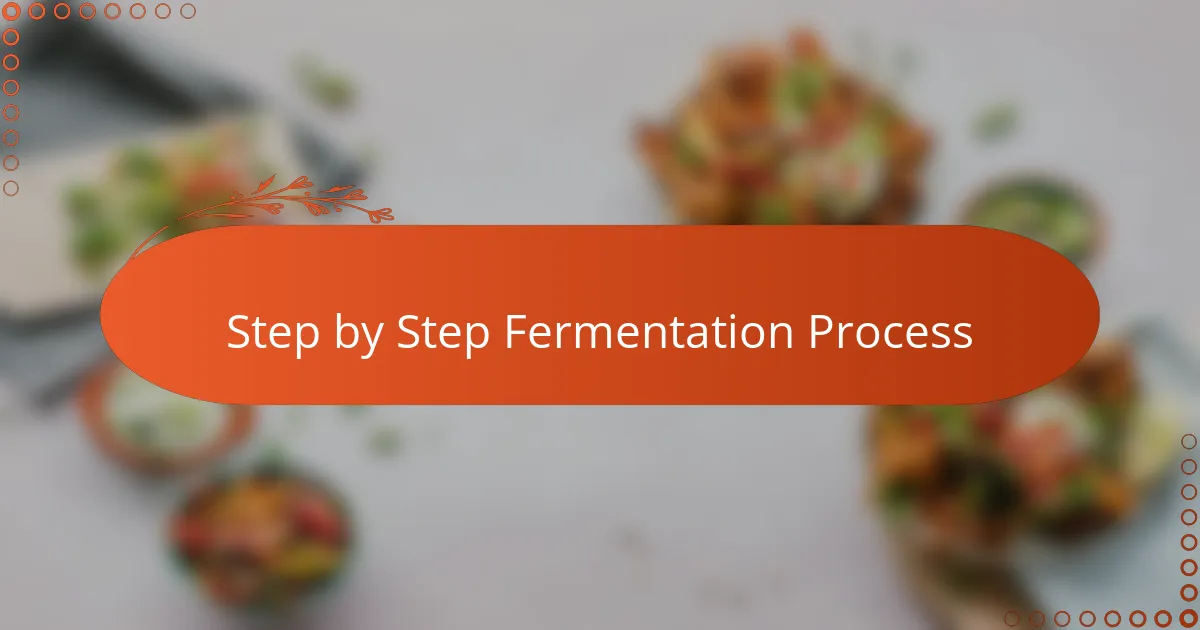
Step by Step Fermentation Process
Once I had my cucumbers ready, the next step was crafting the perfect brine. I carefully dissolved the precise amount of salt in filtered water, knowing that too much or too little could throw off the balance I’d worked hard to achieve. Have you ever tried to guess the right saltiness just by taste? It’s a delicate dance, and I’ve learned that patience and precision pay off big time.
Next came layering the cucumbers and any aromatics I wanted—dill, garlic, or mustard seeds—into the fermentation vessel. I’d press them down firmly to keep everything submerged beneath the brine because exposure to air can lead to unwanted mold or spoilage. I remember the first time I neglected this step and saw fuzzy white patches develop; that was a harsh but valuable lesson in the importance of full submersion.
Finally, I covered the jar with a cloth to allow gas to escape while keeping dust and bugs out, then placed it in a cool, dark spot. Checking on my pickles daily became a small ritual, as I’d see tiny bubbles forming—a lively sign that fermentation was happening. It’s almost like nurturing a tiny ecosystem, and each day brought a new sense of excitement and anticipation.

Tips for Successful Pickling
One tip I swear by is always keeping your cucumbers fully submerged in the brine. I learned the hard way that even a small spot exposed to air can invite mold, turning what should be a tasty batch into a disappointment. Have you ever seen that fuzzy white stuff appear? It’s a clear sign the pickles didn’t get the all-important airtight coverage they need.
Temperature control is something I pay close attention to as well. Fermentation feels like a slow dance with nature, and if your kitchen is too warm, the pickles might turn sour too quickly or lose their crunch. I aim for a cool, stable spot, usually around 65 to 72 degrees Fahrenheit, which keeps the flavor developing just right. It’s surprising how much difference that little thermostat window makes.
Finally, patience is my secret weapon. I remember rushing once and unpacking my jar after just three days only to find bland, underdeveloped flavors. Waiting even a few extra days made all the difference, turning the tang up and the crunch just perfect. Have you ever been tempted to peek early? Trust me, your taste buds will thank you for holding out.

Storing and Using Homemade Pickles
When it comes to storing homemade pickles, I’ve found that keeping them in a cool, dark place is key to maintaining their crunch and flavor. I usually store my jars in the fridge once the fermentation reaches the tanginess I like. Have you noticed how refrigeration slows down the fermentation, preserving those perfect pickles for weeks or even months?
Using homemade pickles feels like having a little gift from your kitchen ready whenever you want it. I often add them to sandwiches or salads, and sometimes just enjoy a few straight from the jar. There’s something deeply satisfying about tasting that burst of tang and crunch, knowing you nurtured each bite from start to finish.
One time, I kept a jar on the counter for too long, and the pickles turned sharper than I expected—lesson learned! I now treat storage like the final step of fermentation, a way to hit pause on the flavors I worked so hard to develop. Have you had a similar experience with pickle storage that taught you a valuable lesson?

Troubleshooting Common Pickling Issues
Sometimes, despite all the care, your pickles might turn out mushy. I’ve found that this usually happens when cucumbers aren’t fresh or the fermentation temperature gets too warm. Have you ever bitten into a soft, disappointing pickle? The first time that happened to me, I realized how critical it is to keep everything cool and use crisp cucumbers.
Another common hiccup is seeing unexpected mold or a fuzzy film on top of your brine. I used to panic when I saw that, but I learned that it often means the cucumbers weren’t fully submerged or the jar wasn’t covered properly. Keeping your pickles underwater and using a breathable cloth cover can save you from this problem—and keep your batch safe and delicious.
If your pickles taste too salty or bland, don’t fret. I once misjudged the salt amount and ended up with pickles that were barely pickled at all. Getting the salt-to-water ratio right is a balancing act, but I discovered it’s worth measuring carefully and tasting the brine before packing the cucumbers. Have you experimented with salt levels yet? It really changes the whole flavor game.
